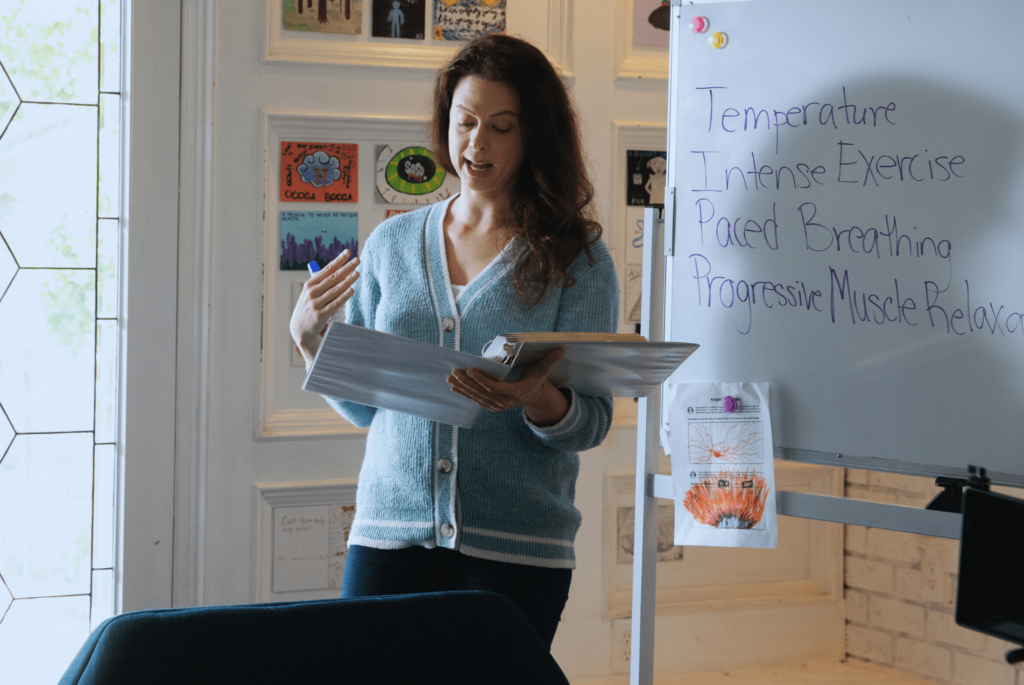
Adolescents encounter stressful situations every day. Whether you’re at school and a friend seems to be avoiding you… or a teacher just assigned another 15-page paper in addition to the five other assignments you have due this week… or you’re waiting for a response to a really sensitive text you sent, and none is forthcoming…
So many of our daily encounters have the potential to make us angry, upset, or anxious. And when combined with a pre-existing mental health issue such as depression or anxiety, adolescents may feel like certain situations are simply insurmountable. You may feel like breaking down and sobbing. Or perhaps you feel a need to smash something. Or vow never to talk to anyone ever again, retreating to your room for isolation.
Thankfully, there is a way to deal with these scenarios that doesn’t include yelling, panicking, or engaging in violence or hurtful behavior. The “magic solution,” as some of the teens in our treatment center like to call it, is DBT, or Dialectical Behavior Therapy. While you won’t be able to wave a wand and suddenly make your frustration vanish, DBT is all about applying certain skills that help you instantly calm down when everyday situations (like the above) make you upset, flustered, or anxious.
If you have received care at one of our programs (or another residential DBT treatment center), some of the following tips will likely be familiar to you. If so, let them serve as a brief refresher! If not, learning these distress-tolerance skills can help anyone who struggles with extreme, dysregulated emotions. While some DBT tips should be applied in a quiet place, when you’re focused, the following can be done anywhere—hence their usefulness when you’re on the go.
Distress Tolerance Skills
Distraction
- Call or text a friend to vent. (Make sure you’re using a hands-free device if you’re in the car, and never text and drive.)
- Mentally push away the experience. Imagine plucking the frustration out of your head, placing it in a box, and putting it on a shelf, at least for the next short while.
- Read a magazine or the news.
- Count all the colors you see in a billboard or poster.
- Repeat the lyrics of a song in your head.
Self-soothing
- Keep a paper with your favorite essential oil on it and sniff it.
- Pet a dog, if you’re outside and the owner allows it.
- Listen to your favorite song on high, or play it over and over again.
- Zone out to something in nature (like a bird on a tree).
- Eat something yummy.
- Hug yourself.
- Rock yourself gently.
Improve the Moment
- Imagine or visualize a calm setting that you enjoy, like the beach, or your favorite place to just be.
- Ask for help in passing the moment.
- Unplug from all electronic devices to give yourself a mental “vacation.”
- Give yourself encouragement by repeating over and over, “I can stand this,” “I can get over this,” “I can stay calm.” Pretend you’re your own cheerleader.
And when nothing else is working, try T.I.P.P. skills—four physiological tricks that instantly calm the mind and body!
The T.I.P.P
- Temperature: Change your body temperature. Go to the nearest bathroom, lean over the sink, and splash your face with cold water. Or, if you happen to have a freezer pack in your lunchbox, hold it to your eyes and cheeks for 30 seconds. It really works!
- Intense Exercise: Go to a corner and do some really intense running, walking, or jumping on the spot to get your heart rate up really quickly. (Some of our teens at Evolve like doing a set of 20 pushups on the spot!) The one caveat is that you need to stop after a short time…10 minutes is ideal. Then let your body bring your heart rate back down naturally.
- Paced Breathing: Breathe from your abdomen. Slow your pace of breathing down, and try to breathe out more slowly than you breathe in…ideally 4 seconds in, 6 out. Keep this up for a minute or two.
- Progressively Relax: Clench your muscles one by one, for a few seconds each, and then let go. Start with your face and work your way down to your chest, hands, fingers, buttocks, legs, and toes. Clench, relax. Clench, relax. You can do this (as well as Paced Breathing) literally wherever you are, so this is a great tip (no pun intended!) while you’re sitting in class or driving.
The next time you encounter a difficult situation—at school, home, or on the go—remember these DBT skills and give them a try. And if you think you’d benefit from learning more of these skills, and may be interested in a structured DBT program for teens, call our admissions team! They will be happy to answer any questions you may have about how DBT can help with teen mental health issues, and will help you determine what type of treatment center may be the best option for you and your family.






























































